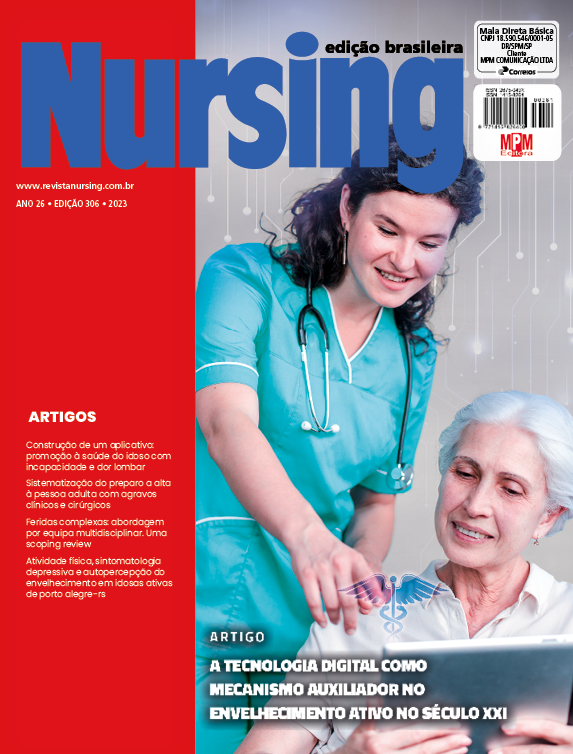Complex wounds: a multidisciplinary team approach. A scoping review.
DOI:
https://doi.org/10.36489/nursing.2023v26i306p10030-10037Keywords:
complex wound, healing, costs, multidisciplinary teamAbstract
Objectives: - to recognise the importance of the multidisciplinary team in the approach to the person with a complex wound in wound healing; - to map the evidence/knowledge on the subject under study.Method: Scoping review carried out between 04 January and 01 February 2020, in the databases Repositório Científico de Acesso Aberto de Portugal (RCAAP), EBSCO host (CINAHL and Medline) and Web of Science, using search strategies adapted to each database.Results and discussion: The scientific evidence demonstrates the importance of multidisciplinary teams in dealing with people with complex wounds.Conclusion: As this is a complex process, it is essential to take into account all the elements that influence and delay healing in order to improve treatment results and associated costs.
References
North American Nursing Diagnosis Association. (2018). Diagnósticos de enfermagem da NANDA: Definições e classificação 2018-2020. Artmed
Biblioteca Virtual em Saúde. (2021). DeCS/MeSH: Descritores em ciências da saúde. https://decs.bvsalud.org/
International Council of Nurses. (2021). ICNP Browser. https://www.icn.ch/what-we-do/projects/ehealth-icnptm/icnp-browser
Farina Junior, J., Almeida, C. E., Garcia, F. L., Lima, R. V., Marques, R. R., & Cologna, M. H. (2013). Tratamento multidisciplinar de feridas complexas. Proposta de criação da “Unidade de Feridas” no Hospital das Clínicas da FMRP-USP. Medicina, 46(4), 355-360. https://doi.org/10.11606/issn.2176-7262.v46i4p355-360
Ferreira, M. C., Tuma, P. Jr., Carvalho, V. F., & Kamamoto, F. (2006). Complex Wounds. Clinics, 61(6), 571-578. https://doi.org/10.1590/S1807-59322006000600014
Marques, R., & Veludo, F. A. (2019). Competências do gestor de feridas: Scoping review. Revista Gaúcha de Enfermagem, 40, e20189241. https://doi.org/10.1590/1983-1447.2019.20180421
Kim, P. J., Evans, K. K., Steinberg, J. S., Pollard, M. E., & Attinger, C. E. (2013). Critical elements to building na effective wound care center. Journal of Vascular Surgery, 57, 1703-1709. http://dx.doi.org/10.1016/j.jvs.2012.11.112
Peters, M. D., Godfrey, C., McInerney, P., Munn, Z., Tricco, A. C., & Khalil, H. (2017). Scoping reviews (2020 version). In E. Aromataris & Z. Munn (Eds.), JBI Manual for evidence synthesis (Chap. 11). https://synthesismanual.jbi.global. https://doi.org/10.46658/JBIMES-20-12
Moher, D., Liberati, A., Tetzlaff, J., & Altman, D. G. (2009). Preferred reporting items for systematic reviews and meta-analyses: The PRISMA statement. Annals of International Medicine, 51(4), 264-269. https://dx.doi.org/10.1371/journal.pmed. 1000097
Alves, P. J. (2014). Feridas: Prevalência e custos (Tese de doutoramento, Universidade Católica Portuguesa). https://repositorio.ucp.pt/handle/10400.14/20105
Maciel, E. A. (2008). Prevalência de feridas em pacientes internados m um hospital filantrópico de grande porte de Belo Horizonte (Dissertação de mestrado, Universidade Federal de Minas Gerais, Escola de Enfermagem, Brasil). https://repositorio.ufmg.br/bitstream/1843/GCPA-7F5JB6/1/erika_maciel.pdf
Vaz, A. J. (2014). Prevalência de feridas num distrito do Norte de Portugal (Dissertação de mestrado, Universidade Católica Portuguesa). http://hdl.handle.net/10400.14/19467
Gaspar, P. J. (2009). Modelo de estimação dos custos da não formação em Saúde no âmbito do diagnóstico e tratamento de feridas crónicas: Uso de simulação da decisão clínica com ferramentas baseadas na Internet (Tese de doutoramento, Universitat Politècnica de Catalunya). http://hdl.handle.net/2117/93864
Milcheski, D. A., Ferreira M. C., Nakamoto, H. A., Pereira, D. D., Batista, B. N., & Tuma Júnior, P. (2013). Uso da terapia por pressão sub-atmosférica em feridas traumáticas agudas. Revista do Colégio Brasileiro de Cirurgiões, 40(5), 392-397. https://doi.org/10.1590/S0100-69912013000500008
Moore, Z., Butcher, G., Corbett, L. P., McGuiness, W., Snyder, R. J., & van Acker, C. (2014). Position paper: Managing Wounds as a Team. Journal of Wound Care, 23(5), SI-S38 https://ewma.org/fileadmin/user_upload/EWMA.org/Project_Portfolio/EWMA_Documents/AAWC_AWMA_EWMA_ManagingWoundAsATeam_FINALdoc.pdf
Xavier, A. C. (2012). Feridas: Caracterização e análise de custos em Moçambique (Dissertação de mestrado, Universidade Católica Portuguesa). http://hdl.handle.net/10400.14/16282
Ousey, K. J., & Milne, J. (2014). Exploring portable negative pressure wound therapy devices in the community. British Journal of Community Nursing, 19(Suppl. 3), S16-20. https://doi.org/10.12968/bjcn.2014.19.sup3.s14
Tricco, A. C., Cogo, E., Isaranuwatchai, W., Khan, P. A., Sanmugalingham, G., Antony, J., Hoch, J. S., & Straus, S. E. (2015). A systematic review of cost-effectiveness analyses of complex wound interventions reveals optimal treatments for specific wound types. BMC Medicine, 13(1), 1-16. https://doi.org/10.1186/s12916-015-0326-3
Elliot, S. (2019). A clinically effective primary wound dressing that supports self-care for chronic and acute wounds. British Journal of Community Nursing, 24(Sup6), S30-S37. https://doi.org/10.12968/bjcn.2019.24.Sup6.S30
Khalil, H., Cullen, M., Chambers, H., Carroll, M., & Walker, J. (2015). Elements affecting wound healing time: An evidence based analysis. Wound Repair and Regeneration, 23(4), 550-556. http://dx.doi.org/10.1111/wrr.12307
Fernández Montequín, J. I. (2011). Heridas de difícil cicatrización. Revista Cubana de Angiología y Cirugía Vascular, 13(1), 1-10. https://www.medigraphic. com/pdfs/revcubangcirvas/cac-2012/cac121i.pdf
Skerritt, L., & Moore, Z. (2014). The prevalence, aetiology and management of wounds in a community care area in Ireland. British Journal of Community Nursing, 19(Suppl. 6), 11-17. https://doi.org/10.12968/bjcn.2014.19.sup6.s11
Gallagher, K., Steven, M., Tinkoff, G., Cardenas, L., & Halbert, C. (2018). Web-Based Support for acute surgical wound care. American Surgeon, 84(2), 50-52. https://doi.org/10.1177/000313481808400204








